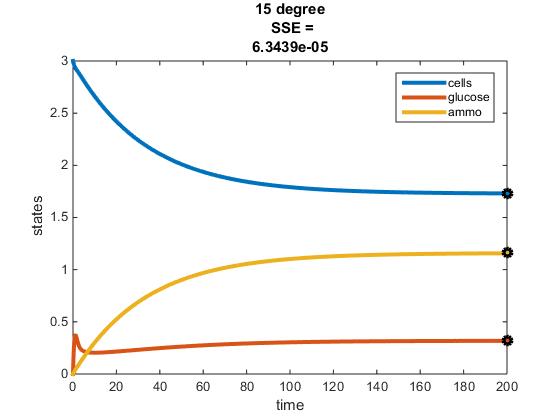Desireegonzalez Week 15
Purpose
- The purpose of this assignment was to work with the given chemostat equations and the Arrhenius equation to edit the model simulations and MATLAB files for chemostat reactions that depicted a temperature dependence and also modeled efficiency and waste.
Methods
- To begin the Arrhenius equation (rate = A*exp(-B/(R*T)) was used to model the temperature dependence of the chemostat reaction.
- This was then used to figure out the constants A and B from the rate data in the TaiParamsRevised.m file.
- MATLAB was then used to simulate the chemostat for T = 15,20, 25 degrees C conditions and graph the time courses of the biomass and nutrients.
- Afterwards, the glucose efficiency/waste constant (that is not really a constant?) was investigated for the glucose-limited and ammonium-limited conditions. Making sure to note the values of E for glucose-limited and ammonium-limited conditions.
- For each temperature (12, 30), a function E(y) that matches the two points of (y,E) data was then found.
- These functions were then used to modify the chemostat_2nutrient_dynamics.m file.The resulting simulations were then compared.
- A 15 minute presentation was then created with the information below.
- A brief intro to the chemostat problem of Tai et al (2007).
- The data we've extracted from the paper and other sources.
- The temperature investigation.
- The efficiency/waste investigation.
- A discussion and reflection on your findings.
Data Files and Calculations
Assignment Week 15 MATLAB Files and Presentation
Results
Results for Temperature Dependency Using Arrhenius Equation
Figure 1: Temperature dependency graph of Glucose limited trial at 15 degrees C.
Figure 2: Temperature dependency graph of Glucose limited trial at 20 degrees C.
Figure 3: Temperature dependency graph of Glucose limited trial at 25 degrees C.
Figure 4: Temperature dependency graph of Glucose limited trial at 12 degrees C.
Results for Efficiency and Waste Modeling
Conclusions
- The purpose of this assignment, to edit the model simulations and MATLAB files for chemostat reactions that depicted a temperature dependence and also modeled efficiency and waste, was fulfilled.
- The experiment looking at temperature dependency model depicted that residual glucose levels decrease as the temperature increases.
- The experiment looking at the efficiency and waste model revealed that there was not a significant difference in the models use of efficiency as E=1/Y or as E=my+b.
Acknowledgements
- I communicated in person with my homework partner, Leanne to go over the calculations and MATLAB simulations that we were going to put into our 15 minute final presentation.
- The MATLAB files needed for the completion of this assignment were provided by Dr. Dahlquist and Dr. Fitzpatrick.
Except for what is noted above, this individual journal entry was completed by me and not copied from another source. Desireegonzalez (talk) 23:52, 8 May 2019 (PDT)
References
Dahlquist, K. & Fitzpatrick, B.G. (2019, May 6). BIOL388/S19:Week 14/15. Retrieved from https://openwetware.org/wiki/BIOL388/S19:Week_14/15 on 7 May 2019.
MATLAB (Version R2014b) [Computer software]. (n.d.). Retrieved 7 May 2019.
Tai, S. L., Boer, V. M., Daran-Lapujade, P., Walsh, M. C., Winde, J. H., & Daran, J. (2005). Two-dimensional Transcriptome Analysis in Chemostat Cultures Combinational Effects of Oxygen Availability and Macronutrient Limitation in Saccharomyces cerevisiae. Retrieved April 22, 2019, from http://www.jbc.org/content/280/1/437.long
Tai, S. L., Daran-Lapujade, P., Walsh, M. C., Pronk, J. T., & Daran, J. (2007). Acclimation of Saccharomyces cerevisiae to Low Temperature: A Chemostat-based Transcriptome Analysis. Molecular Biology of the Cell, 18(12), 5100-5112. doi:10.1091/mbc.e07-02-0131
Below are the links to all the Assignments and Journal Entries of the Spring 2019 Semester.
User Page: user:desireegonzalez
Template Page: template:desireegonzalez
Weekly Assignment Pages:
Individual Journal Entry Pages:
- desireegonzalez Week 1
- desireegonzalez Week 2
- desireegonzalez Week 3
- desireegonzalez Week 4/5
- desireegonzalez Week 6
- desireegonzalez Week 7
- desireegonzalez Week 9
- desireegonzalez Week 10
- desireegonzalez Week 11
- desireegonzalez Week 12
- desireegonzalez Week 15
Shared Journal Pages:




